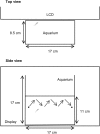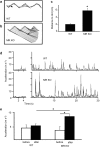Principal function of mineralocorticoid signaling suggested by constitutive knockout of the mineralocorticoid receptor in medaka fish
- PMID: 27897263
- PMCID: PMC5126551
- DOI: 10.1038/srep37991
Principal function of mineralocorticoid signaling suggested by constitutive knockout of the mineralocorticoid receptor in medaka fish
Abstract
As in osmoregulation, mineralocorticoid signaling is implicated in the control of brain-behavior actions. Nevertheless, the understanding of this role is limited, partly due to the mortality of mineralocorticoid receptor (MR)-knockout (KO) mice due to impaired Na+ reabsorption. In teleost fish, a distinct mineralocorticoid system has only been identified recently. Here, we generated a constitutive MR-KO medaka as the first adult-viable MR-KO animal, since MR expression is modest in osmoregulatory organs but high in the brain of adult medaka as for most teleosts. Hyper- and hypo-osmoregulation were normal in MR-KO medaka. When we studied the behavioral phenotypes based on the central MR localization, however, MR-KO medaka failed to track moving dots despite having an increase in acceleration of swimming. These findings reinforce previous results showing a minor role for mineralocorticoid signaling in fish osmoregulation, and provide the first convincing evidence that MR is required for normal locomotor activity in response to visual motion stimuli, but not for the recognition of these stimuli per se. We suggest that MR potentially integrates brain-behavioral and visual responses, which might be a conserved function of mineralocorticoid signaling through vertebrates. Importantly, this fish model allows for the possible identification of novel aspects of mineralocorticoid signaling.
Figures





Similar articles
-
The mineralocorticoid receptor knockout in medaka is further validated by glucocorticoid receptor compensation.Sci Data. 2017 Dec 12;4:170189. doi: 10.1038/sdata.2017.189. Sci Data. 2017. PMID: 29231924 Free PMC article.
-
A possible principal function of corticosteroid signaling that is conserved in vertebrate evolution: Lessons from receptor-knockout small fish.J Steroid Biochem Mol Biol. 2018 Nov;184:57-61. doi: 10.1016/j.jsbmb.2018.02.011. Epub 2018 Feb 23. J Steroid Biochem Mol Biol. 2018. PMID: 29481854 Review.
-
The role of 'mineralocorticoids' in teleost fish: relative importance of glucocorticoid signaling in the osmoregulation and 'central' actions of mineralocorticoid receptor.Gen Comp Endocrinol. 2013 Jan 15;181:223-8. doi: 10.1016/j.ygcen.2012.11.016. Epub 2012 Dec 7. Gen Comp Endocrinol. 2013. PMID: 23220000 Review.
-
Assessment of the role of cortisol and corticosteroid receptors in epidermal ionocyte development in the medaka (Oryzias latipes) embryos.Gen Comp Endocrinol. 2013 Dec 1;194:152-61. doi: 10.1016/j.ygcen.2013.09.011. Epub 2013 Sep 29. Gen Comp Endocrinol. 2013. PMID: 24084592
-
Are we missing a mineralocorticoid in teleost fish? Effects of cortisol, deoxycorticosterone and aldosterone on osmoregulation, gill Na+,K+ -ATPase activity and isoform mRNA levels in Atlantic salmon.Gen Comp Endocrinol. 2008 May 15;157(1):35-40. doi: 10.1016/j.ygcen.2008.03.024. Epub 2008 Mar 31. Gen Comp Endocrinol. 2008. PMID: 18462736
Cited by
-
The mineralocorticoid receptor knockout in medaka is further validated by glucocorticoid receptor compensation.Sci Data. 2017 Dec 12;4:170189. doi: 10.1038/sdata.2017.189. Sci Data. 2017. PMID: 29231924 Free PMC article.
-
Introducing the Amphibious Mudskipper Goby as a Unique Model to Evaluate Neuro/Endocrine Regulation of Behaviors Mediated by Buccal Sensation and Corticosteroids.Int J Mol Sci. 2020 Sep 14;21(18):6748. doi: 10.3390/ijms21186748. Int J Mol Sci. 2020. PMID: 32938015 Free PMC article. Review.
-
Mineralocorticoid receptor activates postnatal adiposity in zebrafish lacking proopiomelanocortin.J Cell Physiol. 2024 Dec;239(12):e31428. doi: 10.1002/jcp.31428. Epub 2024 Sep 5. J Cell Physiol. 2024. PMID: 39238189 Free PMC article.
-
Rainbow Trout (Oncorhynchus mykiss) Pre-Smolts Treated with 11-Deoxycorticosterone Regulate Liver Carbohydrate Metabolism and Gill Osmoregulation.Int J Mol Sci. 2025 Apr 15;26(8):3725. doi: 10.3390/ijms26083725. Int J Mol Sci. 2025. PMID: 40332333 Free PMC article.
-
'Central' Actions of Corticosteroid Signaling Suggested by Constitutive Knockout of Corticosteroid Receptors in Small Fish.Nutrients. 2019 Mar 13;11(3):611. doi: 10.3390/nu11030611. Nutrients. 2019. PMID: 30871191 Free PMC article. Review.
References
-
- Wendelaar Bonga S. E. The stress response in fish. Physiol Rev 77, 591–625 (1997). - PubMed
-
- Prunet P., Sturm A. & Milla S. Multiple corticosteroid receptors in fish: from old ideas to new concepts. Gen Comp Endocrinol 147, 17–23 (2006). - PubMed
-
- Bury N. R. & Sturm A. Evolution of the corticosteroid receptor signalling pathway in fish. Gen Comp Endocrinol 153, 47–56 (2007). - PubMed
-
- Gilmour K. M. Mineralocorticoid receptors and hormones: fishing for answers. Endocrinology 146, 44–46 (2005). - PubMed
-
- Baker M. E. Evolution of glucocorticoid and mineralocorticoid responses: go fish. Endocrinology 144, 4223–4225 (2003). - PubMed
Publication types
MeSH terms
Substances
LinkOut - more resources
Full Text Sources
Other Literature Sources
Medical
Research Materials

